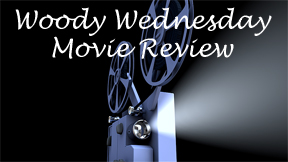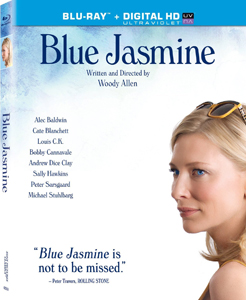Cate Blanchett shines in “Blue Jasmine” (2013), but only figuratively. More literally, as the title character, she sweats, grimaces, shakes and shivers through a masterful performance as someone with clinical anxiety. Writer-director Woody Allen’s film is filled with great actors, but they are all in service (appropriately) to the self-centered Jasmine.
Crazy-good performance
A lot of films show a crazy person muttering on a park bench, but it’s usually for a quick laugh or moment of pathos. In “Blue Jasmine,” we get the complete picture of such a troubled person.
Jasmine doesn’t end up that way because she catches no breaks, nor because she doesn’t work hard. Allen isn’t interested in a catch-all answer, but if there’s a theme here, it might be that there are no shortcuts.

“Blue Jasmine” (2013)
Director: Woody Allen
Writer: Woody Allen
Stars: Cate Blanchett, Alec Baldwin, Peter Sarsgaard
As the film opens, once-rich New Yorker Jasmine has lost everything after the FBI uncovers the Ponzi schemes of her husband, Hal (Alec Baldwin). She moves in with her San Francisco sister Ginger (“The Shape of Water’s” Sally Hawkins) and sees how the other half lives.
But Allen isn’t interested in a comedy or a lecture. Rather, this is a character study.
Jasmine’s contrasts are fascinating, and Blanchett nails the nuances Allen’s screenplay requires. She talks some people’s ear off about her life, and stares into space when others talk to her; she’s largely oblivious to other people, except for broad, stereotypical views.
Still, she works hard to build herself back up. She might be taking the wrong track by trying to “learn computers” in order to then take an online class in interior design.
In a lesser work, I might think the writer is disconnected with reality. Here, I think the point is that Jasmine’s is so disconnected from the non-moneyed life that she makes the long path longer than it needs to be.
No easy way out
But meanwhile, she’s also on the lookout for the shortcut of a quality husband, which she appears to find in Dwight (“Garden State’s” Peter Sarsgaard). This shortcut is something less glamorous sister Ginger, and most men, can’t/don’t have access to.
But it doesn’t mean it’s an easier path: It’s another direction for stresses to come from. And when something goes less than perfectly, Jasmine’s glamorous façade crumbles.
While I think the “learning computers” thing is purposeful, “Blue Jasmine” does have the usual out-of-touch set design element wherein Ginger has a perfectly nice San Francisco apartment despite working as a grocery store clerk.
The multiple references to Ginger’s crappy quality of life only further emphasize that these filmmakers imagine “poor people” as having middle-class lives. But I’ll allow a great film to have one “It’s just a movie” element.
Good guys need not finish last
Allen needle-drops “A Good Man is Hard to Find” not just because he loves old blues, but also because it’s a theme. Ginger’s type is blue-collar guys like Andrew Dice Clay’s furniture mover, Bobby Cannavale’s mechanic and Louis C.K.’s stereo salesman, and Jasmine always rips her for it. When Ginger realizes it’s a good trait to like good men, even if they are blue-collar and imperfect, she’s content.

But again, this isn’t a statement about how money doesn’t buy happiness and how poor people can be happy.
“Blue Jasmine” flashes back to Jasmine’s previous life with Hal, and we see she’s often just as unhappy, and just as anxious, there. Like water, life’s problems find their level.
Allen and Best Actress Oscar-winner Blanchett successfully walk a delicate line wherein “Blue Jasmine” doesn’t let Jasmine off the hook for her treatment of others, yet we also understand she has a clinical problem.
This is on the short list of Allen’s best straight dramas, and one of his best films in which he or an Allen-esque stand-in has no role to play.

